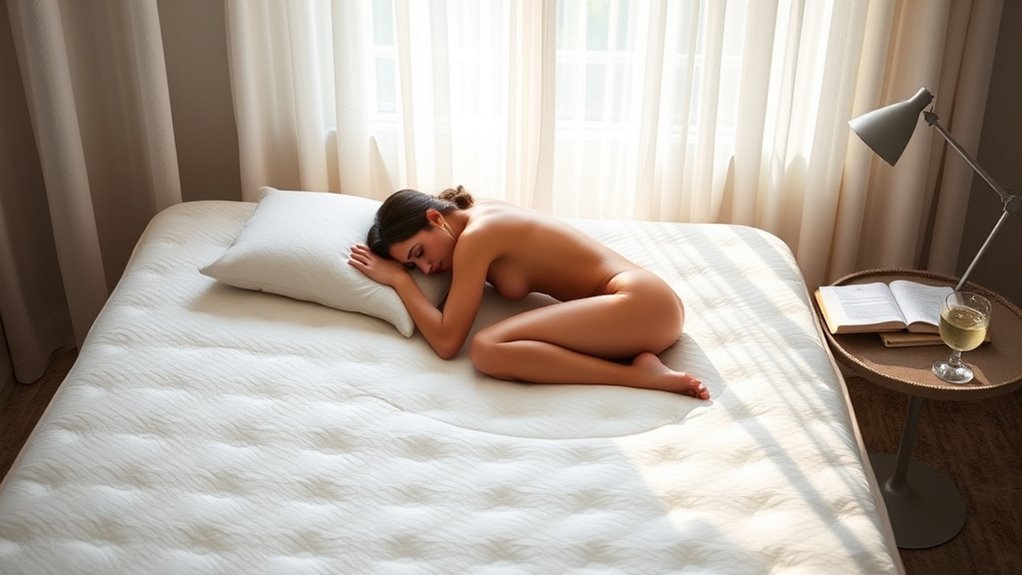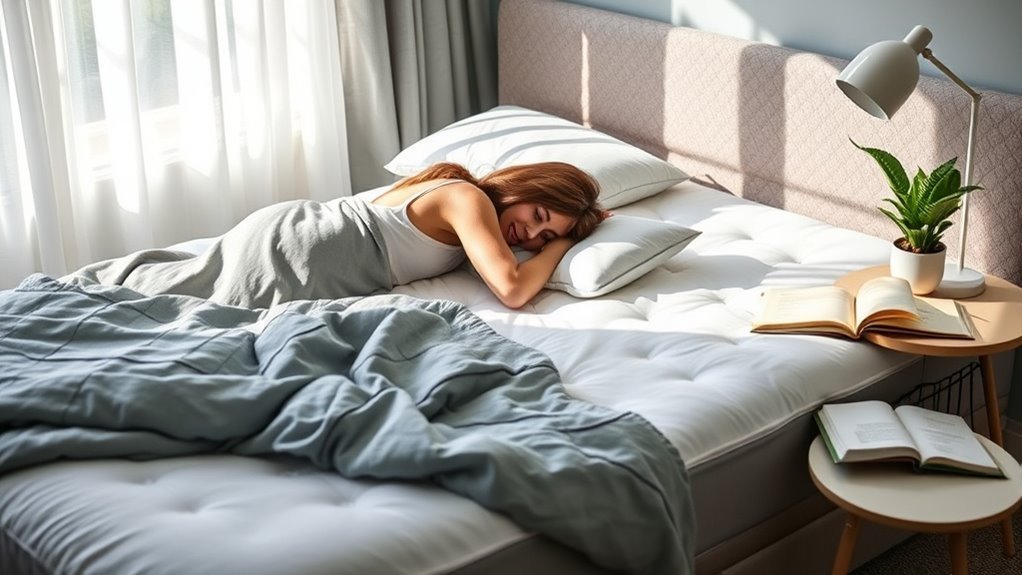When picking a mattress as a side sleeper with arthritis, focus on comfort and pressure relief. Look for materials like memory foam or latex that contour to your body, easing pressure on your shoulders and hips. Aim for medium to medium-soft firmness for the right balance of support and cushioning. Motion isolation is essential to minimize disturbances. Also, consider adjustable bases for better circulation and pain relief. Keep exploring features that enhance your sleep experience for ultimate comfort.
Understanding the Needs of Side Sleepers With Arthritis

When you’re a side sleeper with arthritis, comfort and support become vital for a restful night’s sleep. Your sleep position can greatly impact pain management, as improper alignment can exacerbate discomfort. It’s important to choose a mattress that cushions your joints while maintaining spinal alignment. Look for materials that offer both softness and support; memory foam or latex can be great options. These materials contour to your body, relieving pressure points without sacrificing support. Additionally, consider adjustable bases that allow you to find your ideal elevation, enhancing circulation and reducing pain. Prioritizing your unique needs guarantees you wake up refreshed and ready to embrace the day, free from the limitations arthritis can impose on your life.
Importance of Pressure Relief

Pressure relief is essential for side sleepers, especially those with arthritis, as it directly influences comfort and sleep quality. When you sleep on your side, your body creates pressure points at the shoulders and hips, which can exacerbate discomfort if not properly addressed. A mattress that offers adequate pressure relief helps distribute your body weight evenly, reducing stress on these sensitive areas. This is vital for maintaining a healthy sleep posture, allowing you to wake up feeling refreshed rather than sore. High-quality materials like memory foam or latex can contour to your body, providing the support you need. Prioritizing pressure relief in your mattress choice can ultimately enhance your sleep experience and improve your overall well-being.
Choosing the Right Firmness Level

Selecting the right firmness level for your mattress is essential, especially if you’re a side sleeper dealing with arthritis. You’ll want a mattress that provides ideal support while contouring to your body’s curves. Generally, a medium to medium-soft firmness tends to be best, as it alleviates pressure on your shoulders and hips without sacrificing support for your spine. A mattress that’s too firm can exacerbate discomfort by not allowing your joints to sink in adequately. Conversely, one that’s too soft might lack the support needed for a healthy alignment. Testing various options can help you gauge how each firmness level impacts your comfort and pain relief, allowing you to find the perfect balance for a restful night’s sleep.
Material Considerations for Comfort and Support
When choosing a mattress, the material can greatly impact your comfort and support, especially if you have arthritis. Foam mattresses often contour to your body, providing relief for pressure points, while innerspring options can offer more bounce and support. Hybrid mattresses combine the best of both worlds, giving you a balanced feel that can adapt to your needs as a side sleeper.
Foam vs. Innerspring
While both foam and innerspring mattresses have their merits, understanding how each material affects comfort and support is essential for side sleepers with arthritis.
- Foam types like memory foam contour to your body, relieving pressure points.
- High-density foam offers durability and support, essential for arthritic joints.
- Innerspring options provide bounciness and breathability, which can help with temperature regulation.
- Pocketed coils in innerspring mattresses reduce motion transfer, promoting uninterrupted sleep.
- Consider firmness levels carefully, as both types can vary widely, impacting overall support.
Ultimately, choosing between these materials comes down to your personal comfort preferences and specific needs related to arthritis. Prioritizing your body’s unique requirements will lead you to the best sleeping experience.
Hybrid Mattress Benefits
For many side sleepers with arthritis, hybrid mattresses offer a unique blend of support and comfort by combining the benefits of foam and innerspring materials. The hybrid construction allows you to enjoy the contouring properties of foam, providing pressure relief for your joints, while innerspring coils deliver the support needed for proper spinal alignment. This combination creates hybrid advantages that cater specifically to your needs, allowing for a restful night’s sleep without compromising on comfort. Additionally, the breathability of hybrid mattresses helps regulate temperature, keeping you cool throughout the night. With the right hybrid mattress, you can experience both the freedom of movement and the support essential for managing arthritis pain, enhancing your overall sleep quality.
Motion Isolation and Its Benefits
When you’re a side sleeper with arthritis, motion isolation becomes essential for a restful night’s sleep. A mattress that effectively absorbs movement can help prevent disturbances from your partner’s movements, allowing you to stay comfortable and undisturbed. Understanding the types of materials that provide this benefit can greatly impact your overall sleep quality and well-being.
Importance of Motion Isolation
As you navigate the challenges of sleeping with arthritis, understanding the importance of motion isolation in a mattress can greatly enhance your comfort. A mattress with excellent motion isolation minimizes motion transfer, allowing you to move without disturbing your partner, which is essential for side sleepers needing to adjust their sleeping positions frequently.
- Reduces disturbances during the night
- Provides a more restful sleep experience
- Eases pressure on sensitive joints
- Guarantees stability for changing positions
- Enhances overall sleep quality
Choosing a mattress that excels in motion isolation not only caters to your unique needs as a side sleeper but also fosters a sense of freedom, allowing you to sleep soundly without disruptions or discomfort.
Types of Materials
Choosing the right materials for your mattress can greatly impact how well you manage arthritis symptoms during sleep. For side sleepers, motion isolation is essential, as it minimizes disturbances when shifting positions. Latex foam is a fantastic option; it’s responsive yet supportive, allowing for comfortable pressure relief without compromising stability. Gel-infused memory foam also deserves consideration; it conforms to your body’s unique shape while dissipating heat, ensuring a cooler night’s sleep. Both materials excel at isolating motion, so if you share your bed, you won’t feel every movement. By focusing on these materials, you’re not just investing in comfort, but also in a rejuvenating sleep experience that can help alleviate some of the challenges of arthritis.
Impact on Sleep Quality
A good night’s sleep can make all the difference, especially for side sleepers with arthritis. Motion isolation is essential for improving sleep quality, as it minimizes disturbances caused by movement. Here’s how it can help you:
- Reduces sleep disturbances from your partner’s movements
- Enhances pain management by allowing you to stay in a comfortable position
- Supports spinal alignment, reducing pressure on sensitive joints
- Increases overall comfort, leading to deeper sleep cycles
- Promotes a more restful environment, allowing for quicker relaxation
Choosing a mattress with excellent motion isolation can greatly enhance your sleep quality. By addressing these aspects, you can enjoy the freedom of movement without sacrificing comfort, enabling you to wake up refreshed and ready to tackle the day.
Additional Features to Enhance Sleep Quality
When you’re dealing with arthritis, enhancing your sleep quality goes beyond just picking the right mattress; it’s also about considering additional features that can make a significant difference. Look into sleep accessories like memory foam toppers, which can provide extra cushioning and support, reducing pressure on your joints. An adjustable base can also be a game-changer, allowing you to elevate your legs or upper body for improved circulation and comfort. This flexibility can help relieve pain and make it easier to find a comfortable position throughout the night. Don’t forget about breathable bedding materials, too; they can help regulate your temperature, ensuring you stay cool and cozy as you drift off to sleep.
Frequently Asked Questions
Can I Use a Mattress Topper for Additional Comfort?
Yes, you can definitely use a mattress topper for additional comfort! When choosing one, consider the mattress materials; memory foam or latex can provide great support. The topper thickness matters too—aim for at least 2 to 4 inches for adequate cushioning. A good topper can relieve pressure points and enhance your sleep experience, letting you wake up feeling more refreshed and free to tackle your day!
How Often Should I Replace My Mattress?
You should replace your mattress every 7 to 10 years, much like a tree shedding its leaves. If you’re noticing sagging, lumps, or waking up with aches, those are signs it’s time for a replacement. A mattress’s lifespan can be influenced by usage and care, so keep an eye on its condition. Your comfort and health matter, so don’t wait too long to seek that sweet freedom of a restful night’s sleep.
Are Adjustable Beds Beneficial for Side Sleepers?
Yes, adjustable beds can be incredibly beneficial for side sleepers. They allow you to customize your sleep position, which can help alleviate pressure points and improve spinal alignment. With adjustable benefits, you can elevate your head or legs, reducing discomfort and promoting better circulation. This flexibility lets you find the perfect angle for a restful night’s sleep, giving you the freedom to adjust your environment based on your body’s needs.
What Mattress Brands Are Best for Arthritis?
When choosing a mattress for arthritis, brands like Tempur-Pedic, Saatva, and Purple stand out. Did you know that nearly 80% of people with arthritis report improved sleep quality with the right mattress? Look for options that offer medium to medium-firm firmness, as they provide essential pressure relief while supporting your joints. Prioritizing a mattress that contours to your body can greatly enhance your comfort and freedom to move during sleep.
How Can I Test a Mattress Before Buying?
To test a mattress before buying, visit a store and lie down for at least 10-15 minutes. Pay attention to the mattress firmness; it should support you without causing pressure points. Shift positions to assess pressure relief, especially on your shoulders and hips. If possible, check the return policy for online purchases to guarantee you can try it at home. Finding the right mattress helps you rest easy and feel free from discomfort.



